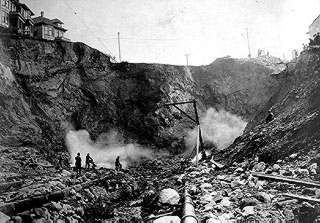|
Subscribe / Renew |
|
|
Contact Us |
|
| ► Subscribe to our Free Weekly Newsletter | |
| home | Welcome, sign in or click here to subscribe. | login |
This Century's Top Ten Construction Projects
|
|
Denny Regrade: Hosing Seattle into shape
Dates:1903-1911; 1929
During the 1880s Seattle was racing toward new status as a major metropolis. City leaders and engineers were determined to create a prosperous town even if that meant changing the landscape to do it. Perhaps the city's most famous physical transformation is the Denny Regrade.
In 1881, city engineer R.H. Thomson began crafting a new landscape for the area. But it was not until 1898, after building new sewer and water systems for the city, that he was able to turn his attention toward leveling streets, beginning with Denny Hill at First Avenue. To garner support from property owners, Thomson hired an assistant to walk door-to-door to explain the project, and its benefits, chiefly that the value of leveled property would increase tenfold. He was right. As Denny Hill melted away, land values soared along Second Avenue. Property owners relished the idea of regrading, and asked for more despite having to foot the bill themselves. Beginning in 1903 and again in 1910, Denny Hill, which once covered 62 city blocks, was whittled away by continuous blasts of water. Twenty million gallons of water a day were pumped from Lake Union to the top of the hill with force enough to move 2,500-pound boulders.
About half of the 16 million cubic yards of dirt removed stayed on site for fill; the rest was dumped in the tideflats between Jackson and Spokane streets, forming Harbor Island. The deepest cut was made near Fourth Avenue and Blanchard Street, where the hill was reduced by 112 feet. The bulk of the regrade was complete by 1911, although the hill wasn't quite level. Work resumed in 1929 to finish the project. By that time, giant steam shovels replaced hoses, scooping and dumping soil onto conveyor belts which moved to follow the digging. Thomson believed his project would create a bustling business district north of Pine Street, but his mission was never fully realized. The Denny Regrade, also known as Belltown, today is home to quirky shops, hip restaurants and apartments rather than towering office buildings. In fact, some argue the regrade may have thwarted development, or at least reduced real estate prices by robbing the potential for expansive city views, like those of houses perched on Queen Anne Hill.
 djc home | top | special issues index
|


